UK Taxation Law and Practice
VerifiedAdded on 2020/06/03
|18
|5214
|42
AI Summary
This assignment delves into the intricate world of UK taxation law and practice. It examines various aspects of the UK tax system, including income tax, corporation tax, capital gains tax, and VAT. The analysis draws upon relevant legislation such as the Taxation on Chargeable Gains Act 1992, Capital Allowances Act 2001, and Corporation Tax Act 2009. Additionally, it explores ethical considerations faced by tax practitioners and the influence of public pressure on corporate tax behavior. Real-world examples and case studies are used to illustrate key concepts and provide practical insights into UK taxation.
Contribute Materials
Your contribution can guide someone’s learning journey. Share your
documents today.
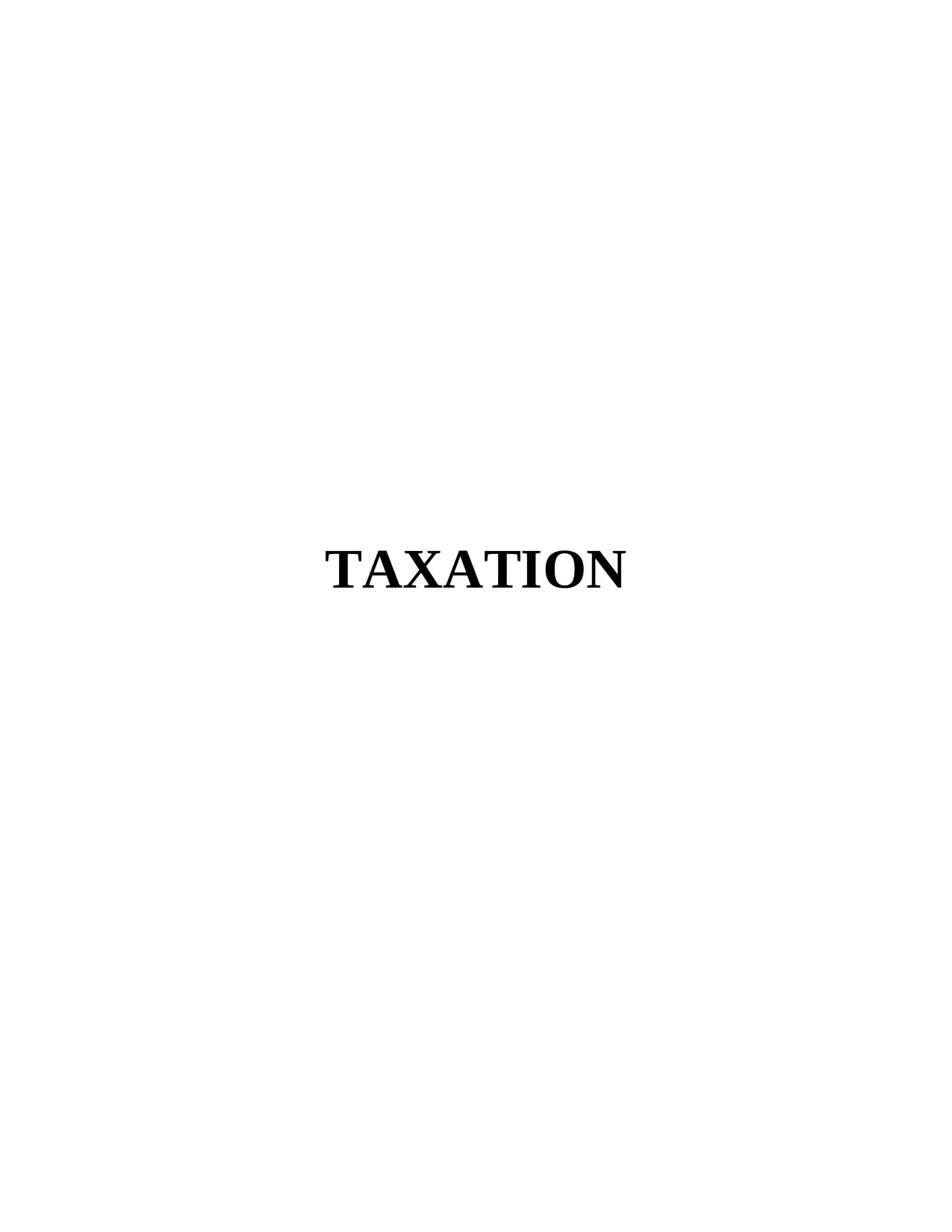
TAXATION
Secure Best Marks with AI Grader
Need help grading? Try our AI Grader for instant feedback on your assignments.

TABLE OF CONTENTS
INTRODUCTION...........................................................................................................................1
TASK 1............................................................................................................................................1
1.1 Explaining tax environment of UK..................................................................................1
1.2 Explaining role and responsibility of tax practitioner......................................................2
1.3 Describing obligations and Non compliance of tax payers..............................................3
M1 Judgement relevant with the roles and responsibilities of tax practitioner......................6
D 3 Ideas and decision to understand the roles and duties of tax practitioners......................6
TASK 2............................................................................................................................................6
2.1 Calculations for Susan's income expenses and allowances..............................................6
2.2 Susan's taxable amount for income generated by various sources...................................8
2.3 Related documents for tax return of Susan.......................................................................9
M 3 Logical development of principle and concepts in analysing tax liabilities.................10
D 2 Managing activities for calculating tax liabilities..........................................................10
TASK 3..........................................................................................................................................11
3.1 Calculations for chargeable income of Aldi stores.........................................................11
3.2 Measuring tax liabilities for the Aldi stores...................................................................12
3.3 Explaining the income tax deductions............................................................................13
4.1 Identification of chargeable income...............................................................................13
4.2 Calculations for capital gains and losses........................................................................14
4.3 Calculations for tax payable on capital gains.................................................................14
M2 Applying techniques for measuring corporate tax.........................................................14
D1 Ideas to measure the Corporate tax Liabilities Capital gain payable.............................14
CONCLUSION..............................................................................................................................14
REFERENCES..............................................................................................................................15
INTRODUCTION...........................................................................................................................1
TASK 1............................................................................................................................................1
1.1 Explaining tax environment of UK..................................................................................1
1.2 Explaining role and responsibility of tax practitioner......................................................2
1.3 Describing obligations and Non compliance of tax payers..............................................3
M1 Judgement relevant with the roles and responsibilities of tax practitioner......................6
D 3 Ideas and decision to understand the roles and duties of tax practitioners......................6
TASK 2............................................................................................................................................6
2.1 Calculations for Susan's income expenses and allowances..............................................6
2.2 Susan's taxable amount for income generated by various sources...................................8
2.3 Related documents for tax return of Susan.......................................................................9
M 3 Logical development of principle and concepts in analysing tax liabilities.................10
D 2 Managing activities for calculating tax liabilities..........................................................10
TASK 3..........................................................................................................................................11
3.1 Calculations for chargeable income of Aldi stores.........................................................11
3.2 Measuring tax liabilities for the Aldi stores...................................................................12
3.3 Explaining the income tax deductions............................................................................13
4.1 Identification of chargeable income...............................................................................13
4.2 Calculations for capital gains and losses........................................................................14
4.3 Calculations for tax payable on capital gains.................................................................14
M2 Applying techniques for measuring corporate tax.........................................................14
D1 Ideas to measure the Corporate tax Liabilities Capital gain payable.............................14
CONCLUSION..............................................................................................................................14
REFERENCES..............................................................................................................................15
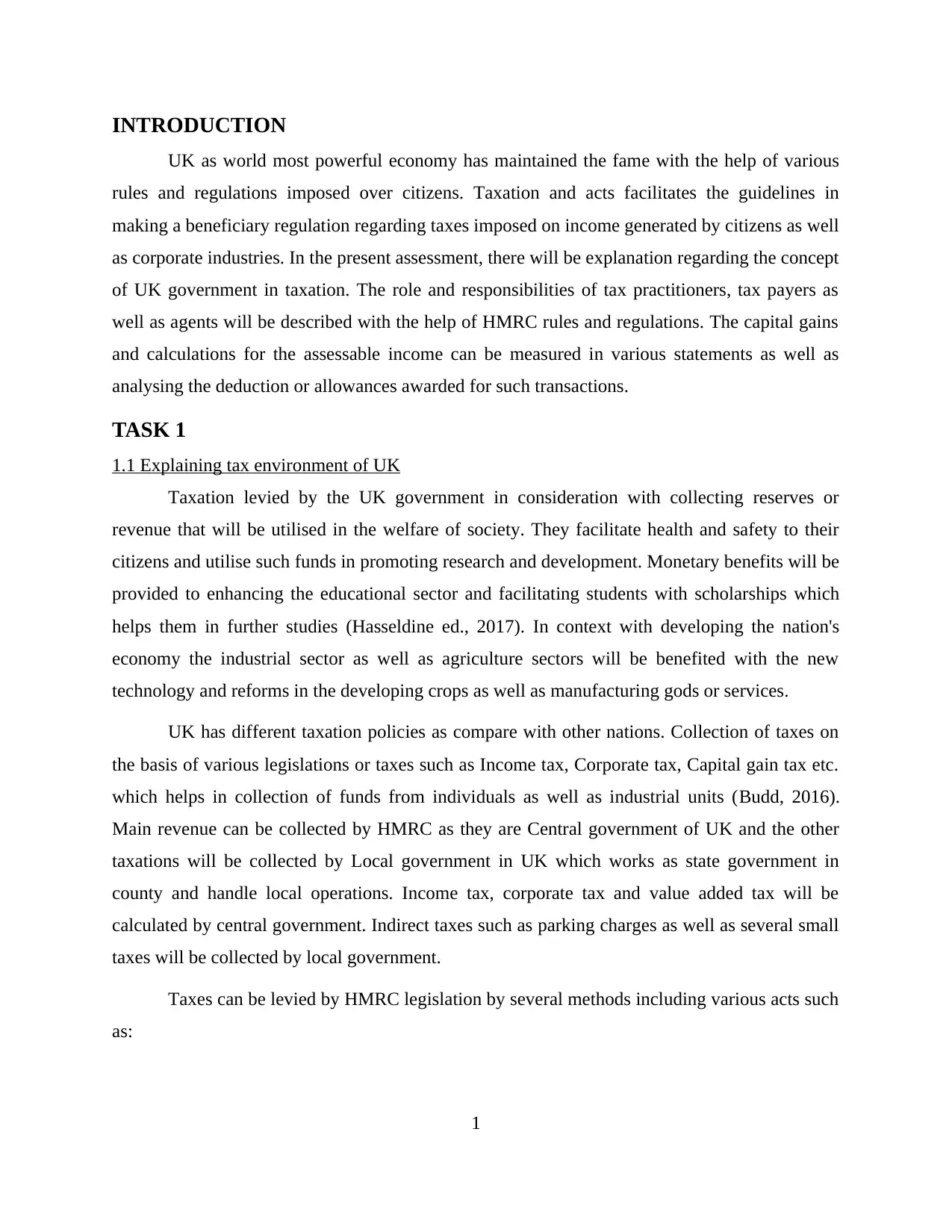
INTRODUCTION
UK as world most powerful economy has maintained the fame with the help of various
rules and regulations imposed over citizens. Taxation and acts facilitates the guidelines in
making a beneficiary regulation regarding taxes imposed on income generated by citizens as well
as corporate industries. In the present assessment, there will be explanation regarding the concept
of UK government in taxation. The role and responsibilities of tax practitioners, tax payers as
well as agents will be described with the help of HMRC rules and regulations. The capital gains
and calculations for the assessable income can be measured in various statements as well as
analysing the deduction or allowances awarded for such transactions.
TASK 1
1.1 Explaining tax environment of UK
Taxation levied by the UK government in consideration with collecting reserves or
revenue that will be utilised in the welfare of society. They facilitate health and safety to their
citizens and utilise such funds in promoting research and development. Monetary benefits will be
provided to enhancing the educational sector and facilitating students with scholarships which
helps them in further studies (Hasseldine ed., 2017). In context with developing the nation's
economy the industrial sector as well as agriculture sectors will be benefited with the new
technology and reforms in the developing crops as well as manufacturing gods or services.
UK has different taxation policies as compare with other nations. Collection of taxes on
the basis of various legislations or taxes such as Income tax, Corporate tax, Capital gain tax etc.
which helps in collection of funds from individuals as well as industrial units (Budd, 2016).
Main revenue can be collected by HMRC as they are Central government of UK and the other
taxations will be collected by Local government in UK which works as state government in
county and handle local operations. Income tax, corporate tax and value added tax will be
calculated by central government. Indirect taxes such as parking charges as well as several small
taxes will be collected by local government.
Taxes can be levied by HMRC legislation by several methods including various acts such
as:
1
UK as world most powerful economy has maintained the fame with the help of various
rules and regulations imposed over citizens. Taxation and acts facilitates the guidelines in
making a beneficiary regulation regarding taxes imposed on income generated by citizens as well
as corporate industries. In the present assessment, there will be explanation regarding the concept
of UK government in taxation. The role and responsibilities of tax practitioners, tax payers as
well as agents will be described with the help of HMRC rules and regulations. The capital gains
and calculations for the assessable income can be measured in various statements as well as
analysing the deduction or allowances awarded for such transactions.
TASK 1
1.1 Explaining tax environment of UK
Taxation levied by the UK government in consideration with collecting reserves or
revenue that will be utilised in the welfare of society. They facilitate health and safety to their
citizens and utilise such funds in promoting research and development. Monetary benefits will be
provided to enhancing the educational sector and facilitating students with scholarships which
helps them in further studies (Hasseldine ed., 2017). In context with developing the nation's
economy the industrial sector as well as agriculture sectors will be benefited with the new
technology and reforms in the developing crops as well as manufacturing gods or services.
UK has different taxation policies as compare with other nations. Collection of taxes on
the basis of various legislations or taxes such as Income tax, Corporate tax, Capital gain tax etc.
which helps in collection of funds from individuals as well as industrial units (Budd, 2016).
Main revenue can be collected by HMRC as they are Central government of UK and the other
taxations will be collected by Local government in UK which works as state government in
county and handle local operations. Income tax, corporate tax and value added tax will be
calculated by central government. Indirect taxes such as parking charges as well as several small
taxes will be collected by local government.
Taxes can be levied by HMRC legislation by several methods including various acts such
as:
1
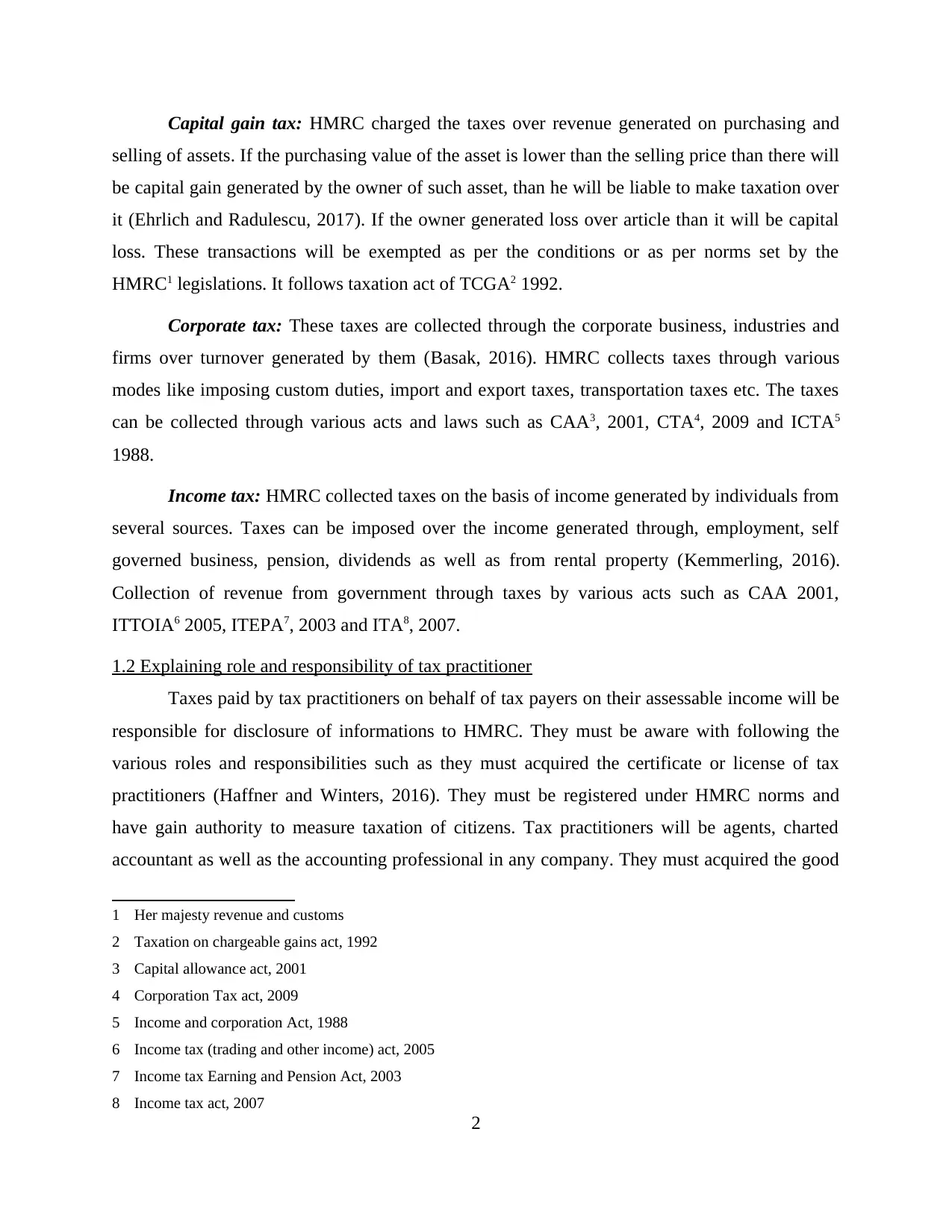
Capital gain tax: HMRC charged the taxes over revenue generated on purchasing and
selling of assets. If the purchasing value of the asset is lower than the selling price than there will
be capital gain generated by the owner of such asset, than he will be liable to make taxation over
it (Ehrlich and Radulescu, 2017). If the owner generated loss over article than it will be capital
loss. These transactions will be exempted as per the conditions or as per norms set by the
HMRC1 legislations. It follows taxation act of TCGA2 1992.
Corporate tax: These taxes are collected through the corporate business, industries and
firms over turnover generated by them (Basak, 2016). HMRC collects taxes through various
modes like imposing custom duties, import and export taxes, transportation taxes etc. The taxes
can be collected through various acts and laws such as CAA3, 2001, CTA4, 2009 and ICTA5
1988.
Income tax: HMRC collected taxes on the basis of income generated by individuals from
several sources. Taxes can be imposed over the income generated through, employment, self
governed business, pension, dividends as well as from rental property (Kemmerling, 2016).
Collection of revenue from government through taxes by various acts such as CAA 2001,
ITTOIA6 2005, ITEPA7, 2003 and ITA8, 2007.
1.2 Explaining role and responsibility of tax practitioner
Taxes paid by tax practitioners on behalf of tax payers on their assessable income will be
responsible for disclosure of informations to HMRC. They must be aware with following the
various roles and responsibilities such as they must acquired the certificate or license of tax
practitioners (Haffner and Winters, 2016). They must be registered under HMRC norms and
have gain authority to measure taxation of citizens. Tax practitioners will be agents, charted
accountant as well as the accounting professional in any company. They must acquired the good
1 Her majesty revenue and customs
2 Taxation on chargeable gains act, 1992
3 Capital allowance act, 2001
4 Corporation Tax act, 2009
5 Income and corporation Act, 1988
6 Income tax (trading and other income) act, 2005
7 Income tax Earning and Pension Act, 2003
8 Income tax act, 2007
2
selling of assets. If the purchasing value of the asset is lower than the selling price than there will
be capital gain generated by the owner of such asset, than he will be liable to make taxation over
it (Ehrlich and Radulescu, 2017). If the owner generated loss over article than it will be capital
loss. These transactions will be exempted as per the conditions or as per norms set by the
HMRC1 legislations. It follows taxation act of TCGA2 1992.
Corporate tax: These taxes are collected through the corporate business, industries and
firms over turnover generated by them (Basak, 2016). HMRC collects taxes through various
modes like imposing custom duties, import and export taxes, transportation taxes etc. The taxes
can be collected through various acts and laws such as CAA3, 2001, CTA4, 2009 and ICTA5
1988.
Income tax: HMRC collected taxes on the basis of income generated by individuals from
several sources. Taxes can be imposed over the income generated through, employment, self
governed business, pension, dividends as well as from rental property (Kemmerling, 2016).
Collection of revenue from government through taxes by various acts such as CAA 2001,
ITTOIA6 2005, ITEPA7, 2003 and ITA8, 2007.
1.2 Explaining role and responsibility of tax practitioner
Taxes paid by tax practitioners on behalf of tax payers on their assessable income will be
responsible for disclosure of informations to HMRC. They must be aware with following the
various roles and responsibilities such as they must acquired the certificate or license of tax
practitioners (Haffner and Winters, 2016). They must be registered under HMRC norms and
have gain authority to measure taxation of citizens. Tax practitioners will be agents, charted
accountant as well as the accounting professional in any company. They must acquired the good
1 Her majesty revenue and customs
2 Taxation on chargeable gains act, 1992
3 Capital allowance act, 2001
4 Corporation Tax act, 2009
5 Income and corporation Act, 1988
6 Income tax (trading and other income) act, 2005
7 Income tax Earning and Pension Act, 2003
8 Income tax act, 2007
2
Secure Best Marks with AI Grader
Need help grading? Try our AI Grader for instant feedback on your assignments.
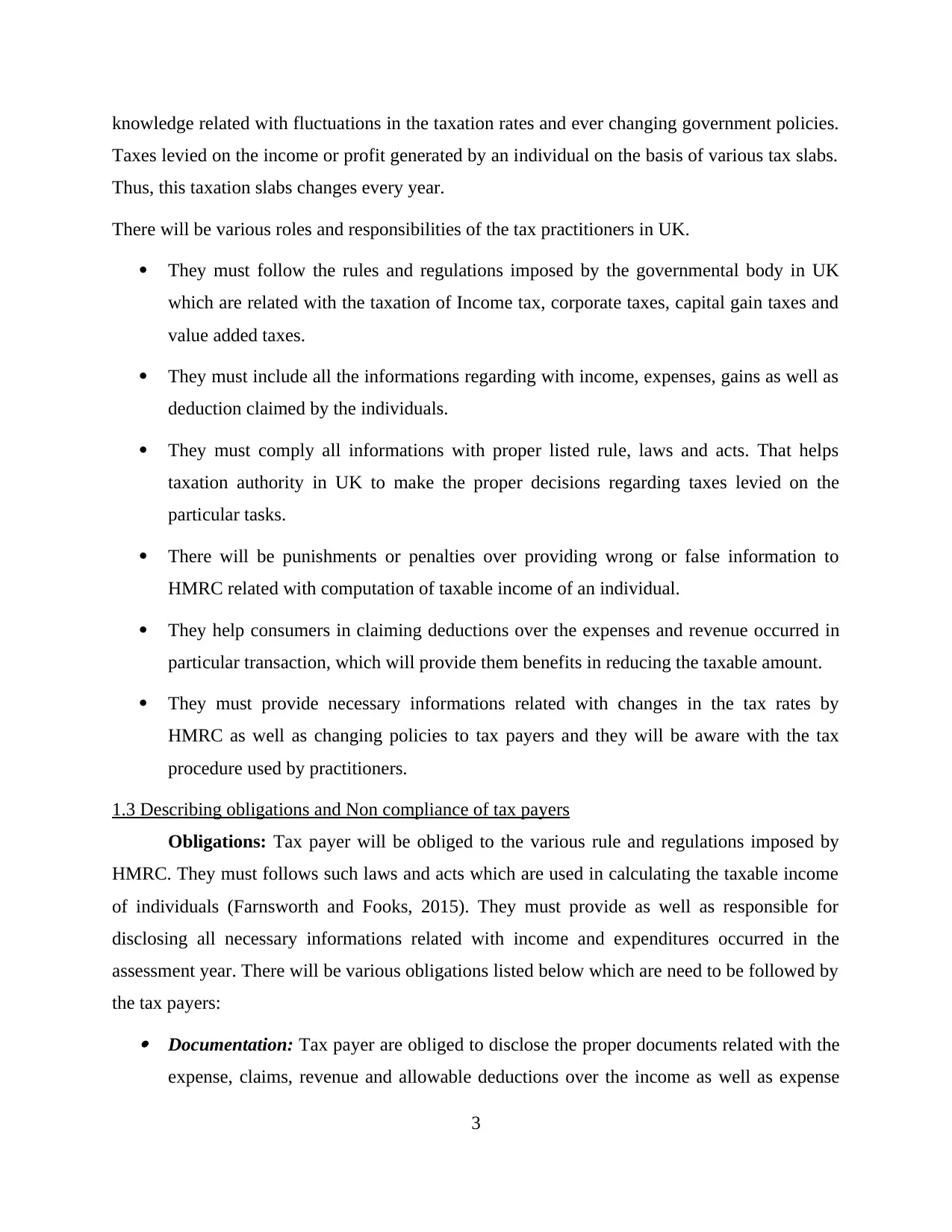
knowledge related with fluctuations in the taxation rates and ever changing government policies.
Taxes levied on the income or profit generated by an individual on the basis of various tax slabs.
Thus, this taxation slabs changes every year.
There will be various roles and responsibilities of the tax practitioners in UK.
They must follow the rules and regulations imposed by the governmental body in UK
which are related with the taxation of Income tax, corporate taxes, capital gain taxes and
value added taxes.
They must include all the informations regarding with income, expenses, gains as well as
deduction claimed by the individuals.
They must comply all informations with proper listed rule, laws and acts. That helps
taxation authority in UK to make the proper decisions regarding taxes levied on the
particular tasks.
There will be punishments or penalties over providing wrong or false information to
HMRC related with computation of taxable income of an individual.
They help consumers in claiming deductions over the expenses and revenue occurred in
particular transaction, which will provide them benefits in reducing the taxable amount.
They must provide necessary informations related with changes in the tax rates by
HMRC as well as changing policies to tax payers and they will be aware with the tax
procedure used by practitioners.
1.3 Describing obligations and Non compliance of tax payers
Obligations: Tax payer will be obliged to the various rule and regulations imposed by
HMRC. They must follows such laws and acts which are used in calculating the taxable income
of individuals (Farnsworth and Fooks, 2015). They must provide as well as responsible for
disclosing all necessary informations related with income and expenditures occurred in the
assessment year. There will be various obligations listed below which are need to be followed by
the tax payers: Documentation: Tax payer are obliged to disclose the proper documents related with the
expense, claims, revenue and allowable deductions over the income as well as expense
3
Taxes levied on the income or profit generated by an individual on the basis of various tax slabs.
Thus, this taxation slabs changes every year.
There will be various roles and responsibilities of the tax practitioners in UK.
They must follow the rules and regulations imposed by the governmental body in UK
which are related with the taxation of Income tax, corporate taxes, capital gain taxes and
value added taxes.
They must include all the informations regarding with income, expenses, gains as well as
deduction claimed by the individuals.
They must comply all informations with proper listed rule, laws and acts. That helps
taxation authority in UK to make the proper decisions regarding taxes levied on the
particular tasks.
There will be punishments or penalties over providing wrong or false information to
HMRC related with computation of taxable income of an individual.
They help consumers in claiming deductions over the expenses and revenue occurred in
particular transaction, which will provide them benefits in reducing the taxable amount.
They must provide necessary informations related with changes in the tax rates by
HMRC as well as changing policies to tax payers and they will be aware with the tax
procedure used by practitioners.
1.3 Describing obligations and Non compliance of tax payers
Obligations: Tax payer will be obliged to the various rule and regulations imposed by
HMRC. They must follows such laws and acts which are used in calculating the taxable income
of individuals (Farnsworth and Fooks, 2015). They must provide as well as responsible for
disclosing all necessary informations related with income and expenditures occurred in the
assessment year. There will be various obligations listed below which are need to be followed by
the tax payers: Documentation: Tax payer are obliged to disclose the proper documents related with the
expense, claims, revenue and allowable deductions over the income as well as expense
3
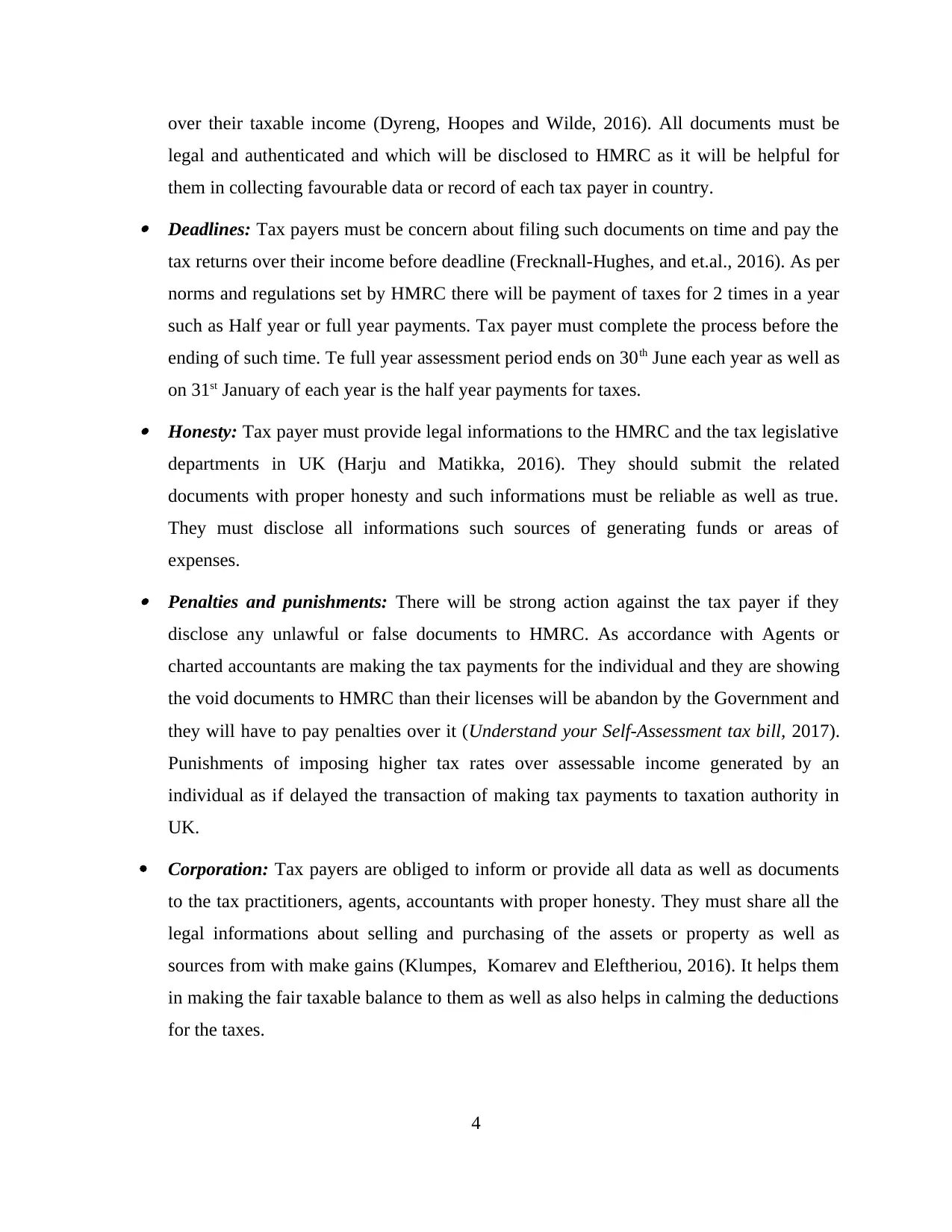
over their taxable income (Dyreng, Hoopes and Wilde, 2016). All documents must be
legal and authenticated and which will be disclosed to HMRC as it will be helpful for
them in collecting favourable data or record of each tax payer in country. Deadlines: Tax payers must be concern about filing such documents on time and pay the
tax returns over their income before deadline (Frecknall-Hughes, and et.al., 2016). As per
norms and regulations set by HMRC there will be payment of taxes for 2 times in a year
such as Half year or full year payments. Tax payer must complete the process before the
ending of such time. Te full year assessment period ends on 30th June each year as well as
on 31st January of each year is the half year payments for taxes. Honesty: Tax payer must provide legal informations to the HMRC and the tax legislative
departments in UK (Harju and Matikka, 2016). They should submit the related
documents with proper honesty and such informations must be reliable as well as true.
They must disclose all informations such sources of generating funds or areas of
expenses. Penalties and punishments: There will be strong action against the tax payer if they
disclose any unlawful or false documents to HMRC. As accordance with Agents or
charted accountants are making the tax payments for the individual and they are showing
the void documents to HMRC than their licenses will be abandon by the Government and
they will have to pay penalties over it (Understand your Self-Assessment tax bill, 2017).
Punishments of imposing higher tax rates over assessable income generated by an
individual as if delayed the transaction of making tax payments to taxation authority in
UK.
Corporation: Tax payers are obliged to inform or provide all data as well as documents
to the tax practitioners, agents, accountants with proper honesty. They must share all the
legal informations about selling and purchasing of the assets or property as well as
sources from with make gains (Klumpes, Komarev and Eleftheriou, 2016). It helps them
in making the fair taxable balance to them as well as also helps in calming the deductions
for the taxes.
4
legal and authenticated and which will be disclosed to HMRC as it will be helpful for
them in collecting favourable data or record of each tax payer in country. Deadlines: Tax payers must be concern about filing such documents on time and pay the
tax returns over their income before deadline (Frecknall-Hughes, and et.al., 2016). As per
norms and regulations set by HMRC there will be payment of taxes for 2 times in a year
such as Half year or full year payments. Tax payer must complete the process before the
ending of such time. Te full year assessment period ends on 30th June each year as well as
on 31st January of each year is the half year payments for taxes. Honesty: Tax payer must provide legal informations to the HMRC and the tax legislative
departments in UK (Harju and Matikka, 2016). They should submit the related
documents with proper honesty and such informations must be reliable as well as true.
They must disclose all informations such sources of generating funds or areas of
expenses. Penalties and punishments: There will be strong action against the tax payer if they
disclose any unlawful or false documents to HMRC. As accordance with Agents or
charted accountants are making the tax payments for the individual and they are showing
the void documents to HMRC than their licenses will be abandon by the Government and
they will have to pay penalties over it (Understand your Self-Assessment tax bill, 2017).
Punishments of imposing higher tax rates over assessable income generated by an
individual as if delayed the transaction of making tax payments to taxation authority in
UK.
Corporation: Tax payers are obliged to inform or provide all data as well as documents
to the tax practitioners, agents, accountants with proper honesty. They must share all the
legal informations about selling and purchasing of the assets or property as well as
sources from with make gains (Klumpes, Komarev and Eleftheriou, 2016). It helps them
in making the fair taxable balance to them as well as also helps in calming the deductions
for the taxes.
4
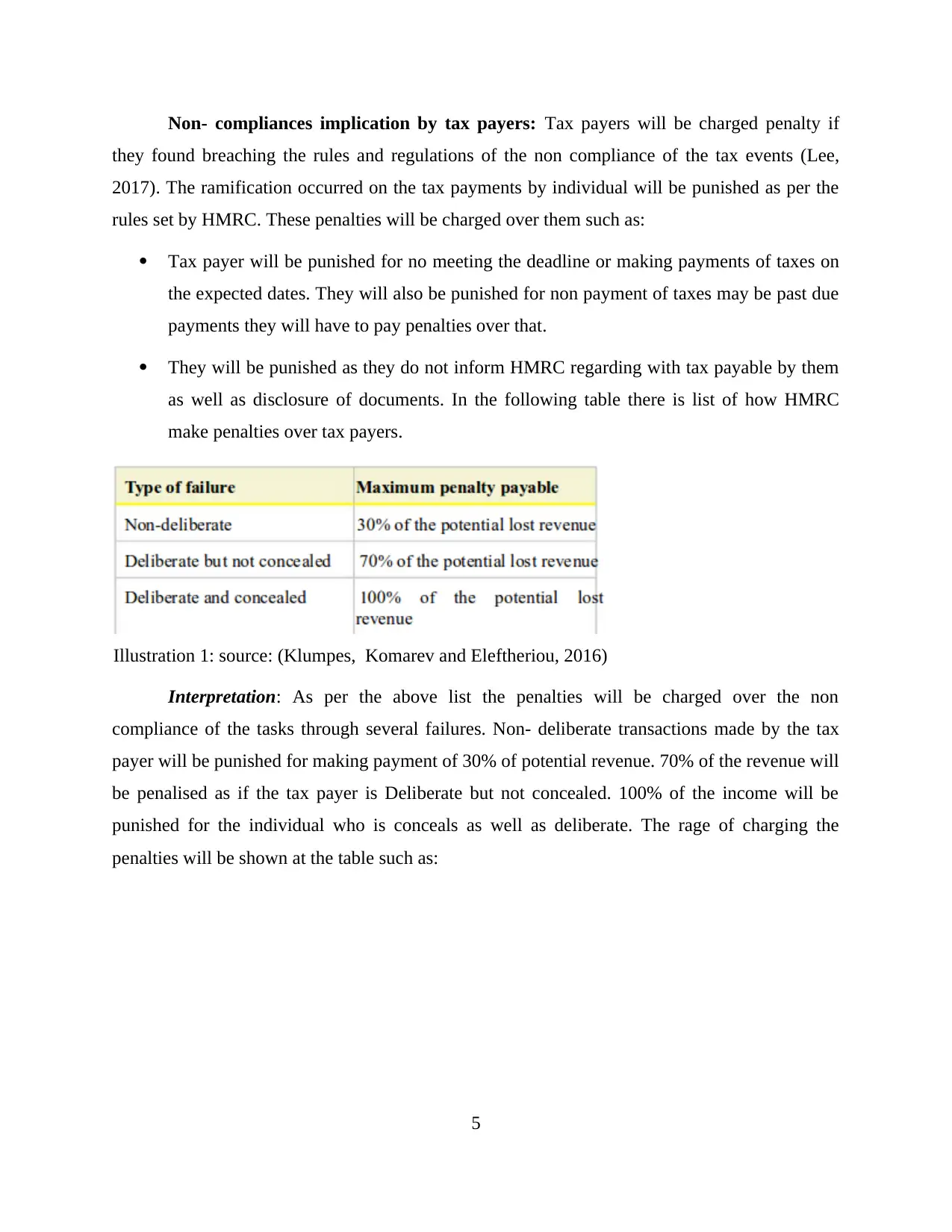
Non- compliances implication by tax payers: Tax payers will be charged penalty if
they found breaching the rules and regulations of the non compliance of the tax events (Lee,
2017). The ramification occurred on the tax payments by individual will be punished as per the
rules set by HMRC. These penalties will be charged over them such as:
Tax payer will be punished for no meeting the deadline or making payments of taxes on
the expected dates. They will also be punished for non payment of taxes may be past due
payments they will have to pay penalties over that.
They will be punished as they do not inform HMRC regarding with tax payable by them
as well as disclosure of documents. In the following table there is list of how HMRC
make penalties over tax payers.
Illustration 1: source: (Klumpes, Komarev and Eleftheriou, 2016)
Interpretation: As per the above list the penalties will be charged over the non
compliance of the tasks through several failures. Non- deliberate transactions made by the tax
payer will be punished for making payment of 30% of potential revenue. 70% of the revenue will
be penalised as if the tax payer is Deliberate but not concealed. 100% of the income will be
punished for the individual who is conceals as well as deliberate. The rage of charging the
penalties will be shown at the table such as:
5
they found breaching the rules and regulations of the non compliance of the tax events (Lee,
2017). The ramification occurred on the tax payments by individual will be punished as per the
rules set by HMRC. These penalties will be charged over them such as:
Tax payer will be punished for no meeting the deadline or making payments of taxes on
the expected dates. They will also be punished for non payment of taxes may be past due
payments they will have to pay penalties over that.
They will be punished as they do not inform HMRC regarding with tax payable by them
as well as disclosure of documents. In the following table there is list of how HMRC
make penalties over tax payers.
Illustration 1: source: (Klumpes, Komarev and Eleftheriou, 2016)
Interpretation: As per the above list the penalties will be charged over the non
compliance of the tasks through several failures. Non- deliberate transactions made by the tax
payer will be punished for making payment of 30% of potential revenue. 70% of the revenue will
be penalised as if the tax payer is Deliberate but not concealed. 100% of the income will be
punished for the individual who is conceals as well as deliberate. The rage of charging the
penalties will be shown at the table such as:
5
Paraphrase This Document
Need a fresh take? Get an instant paraphrase of this document with our AI Paraphraser
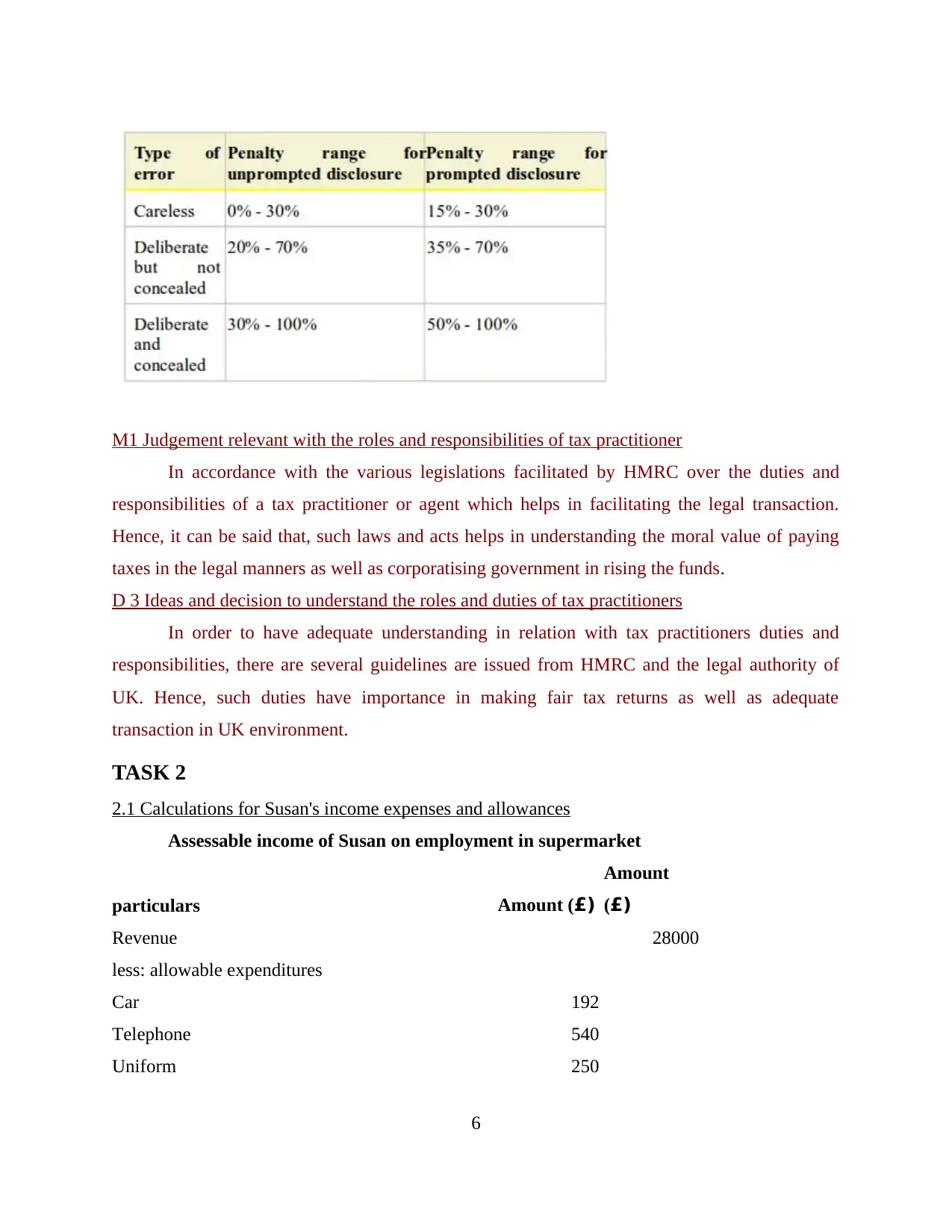
M1 Judgement relevant with the roles and responsibilities of tax practitioner
In accordance with the various legislations facilitated by HMRC over the duties and
responsibilities of a tax practitioner or agent which helps in facilitating the legal transaction.
Hence, it can be said that, such laws and acts helps in understanding the moral value of paying
taxes in the legal manners as well as corporatising government in rising the funds.
D 3 Ideas and decision to understand the roles and duties of tax practitioners
In order to have adequate understanding in relation with tax practitioners duties and
responsibilities, there are several guidelines are issued from HMRC and the legal authority of
UK. Hence, such duties have importance in making fair tax returns as well as adequate
transaction in UK environment.
TASK 2
2.1 Calculations for Susan's income expenses and allowances
Assessable income of Susan on employment in supermarket
particulars Amount (£)
Amount
(£)
Revenue 28000
less: allowable expenditures
Car 192
Telephone 540
Uniform 250
6
In accordance with the various legislations facilitated by HMRC over the duties and
responsibilities of a tax practitioner or agent which helps in facilitating the legal transaction.
Hence, it can be said that, such laws and acts helps in understanding the moral value of paying
taxes in the legal manners as well as corporatising government in rising the funds.
D 3 Ideas and decision to understand the roles and duties of tax practitioners
In order to have adequate understanding in relation with tax practitioners duties and
responsibilities, there are several guidelines are issued from HMRC and the legal authority of
UK. Hence, such duties have importance in making fair tax returns as well as adequate
transaction in UK environment.
TASK 2
2.1 Calculations for Susan's income expenses and allowances
Assessable income of Susan on employment in supermarket
particulars Amount (£)
Amount
(£)
Revenue 28000
less: allowable expenditures
Car 192
Telephone 540
Uniform 250
6
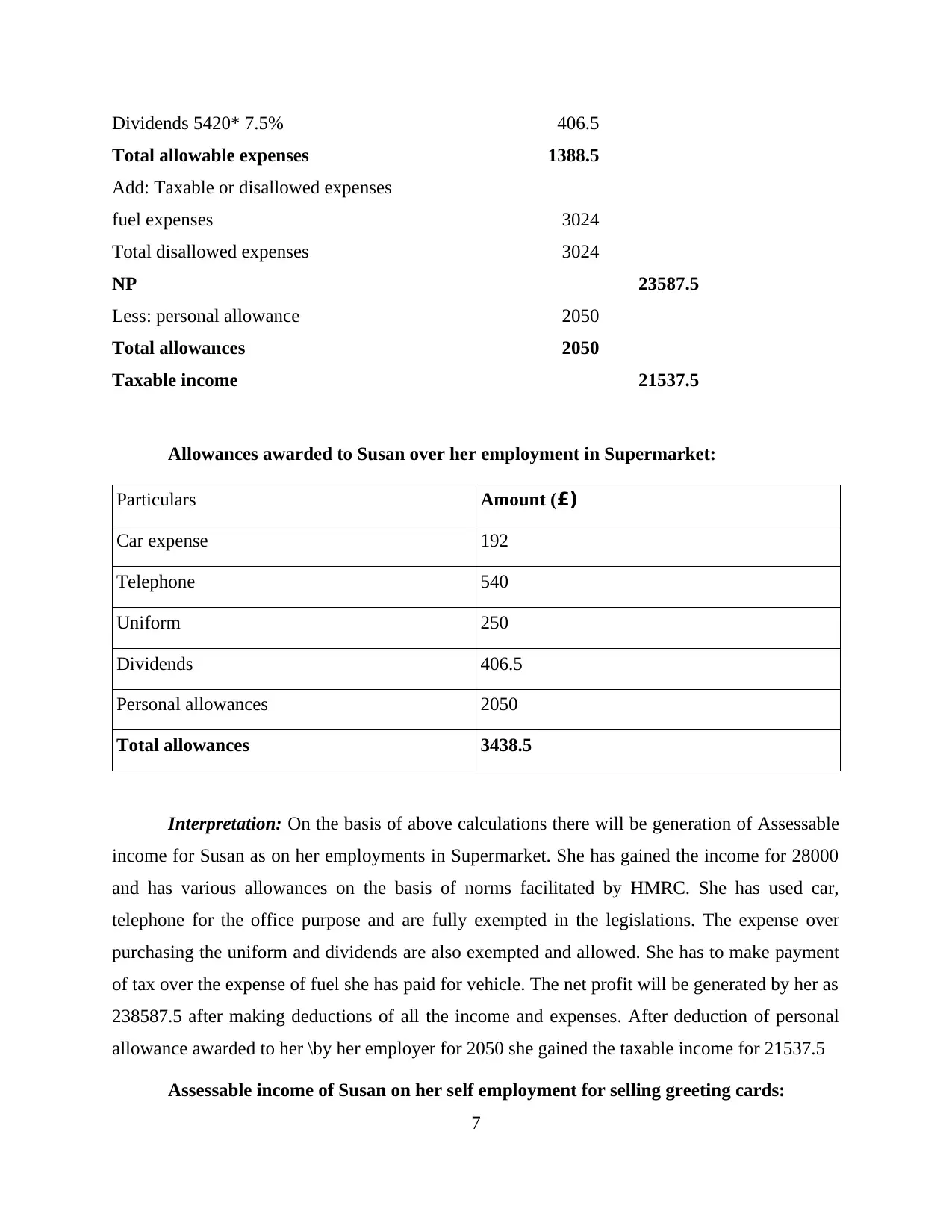
Dividends 5420* 7.5% 406.5
Total allowable expenses 1388.5
Add: Taxable or disallowed expenses
fuel expenses 3024
Total disallowed expenses 3024
NP 23587.5
Less: personal allowance 2050
Total allowances 2050
Taxable income 21537.5
Allowances awarded to Susan over her employment in Supermarket:
Particulars Amount (£)
Car expense 192
Telephone 540
Uniform 250
Dividends 406.5
Personal allowances 2050
Total allowances 3438.5
Interpretation: On the basis of above calculations there will be generation of Assessable
income for Susan as on her employments in Supermarket. She has gained the income for 28000
and has various allowances on the basis of norms facilitated by HMRC. She has used car,
telephone for the office purpose and are fully exempted in the legislations. The expense over
purchasing the uniform and dividends are also exempted and allowed. She has to make payment
of tax over the expense of fuel she has paid for vehicle. The net profit will be generated by her as
238587.5 after making deductions of all the income and expenses. After deduction of personal
allowance awarded to her \by her employer for 2050 she gained the taxable income for 21537.5
Assessable income of Susan on her self employment for selling greeting cards:
7
Total allowable expenses 1388.5
Add: Taxable or disallowed expenses
fuel expenses 3024
Total disallowed expenses 3024
NP 23587.5
Less: personal allowance 2050
Total allowances 2050
Taxable income 21537.5
Allowances awarded to Susan over her employment in Supermarket:
Particulars Amount (£)
Car expense 192
Telephone 540
Uniform 250
Dividends 406.5
Personal allowances 2050
Total allowances 3438.5
Interpretation: On the basis of above calculations there will be generation of Assessable
income for Susan as on her employments in Supermarket. She has gained the income for 28000
and has various allowances on the basis of norms facilitated by HMRC. She has used car,
telephone for the office purpose and are fully exempted in the legislations. The expense over
purchasing the uniform and dividends are also exempted and allowed. She has to make payment
of tax over the expense of fuel she has paid for vehicle. The net profit will be generated by her as
238587.5 after making deductions of all the income and expenses. After deduction of personal
allowance awarded to her \by her employer for 2050 she gained the taxable income for 21537.5
Assessable income of Susan on her self employment for selling greeting cards:
7

Self employment income generated by Susan
particulars Amount (£)
Amount
(£)
Income 40000
less: allowable expenditures
Travel expenses 2300
Rent 410
Insurance 1050
Printing machinery 728
Total allowable expenses 4488
Add: Taxable or disallowed expenses
Depreciation 495
Total disallowed expenses 495
NP 36007
Less: personal allowance
Trading loss 4000
Total allowances 4000
Taxable income 32007
Allowances Awarded to Susan on her self governed business:
Particulars Amount (£)
Travel expense 2300
Rent 410
Insurance 1050
Printing machinery 728
Trading loss 4000
Total allowances 8488
8
particulars Amount (£)
Amount
(£)
Income 40000
less: allowable expenditures
Travel expenses 2300
Rent 410
Insurance 1050
Printing machinery 728
Total allowable expenses 4488
Add: Taxable or disallowed expenses
Depreciation 495
Total disallowed expenses 495
NP 36007
Less: personal allowance
Trading loss 4000
Total allowances 4000
Taxable income 32007
Allowances Awarded to Susan on her self governed business:
Particulars Amount (£)
Travel expense 2300
Rent 410
Insurance 1050
Printing machinery 728
Trading loss 4000
Total allowances 8488
8
Secure Best Marks with AI Grader
Need help grading? Try our AI Grader for instant feedback on your assignments.
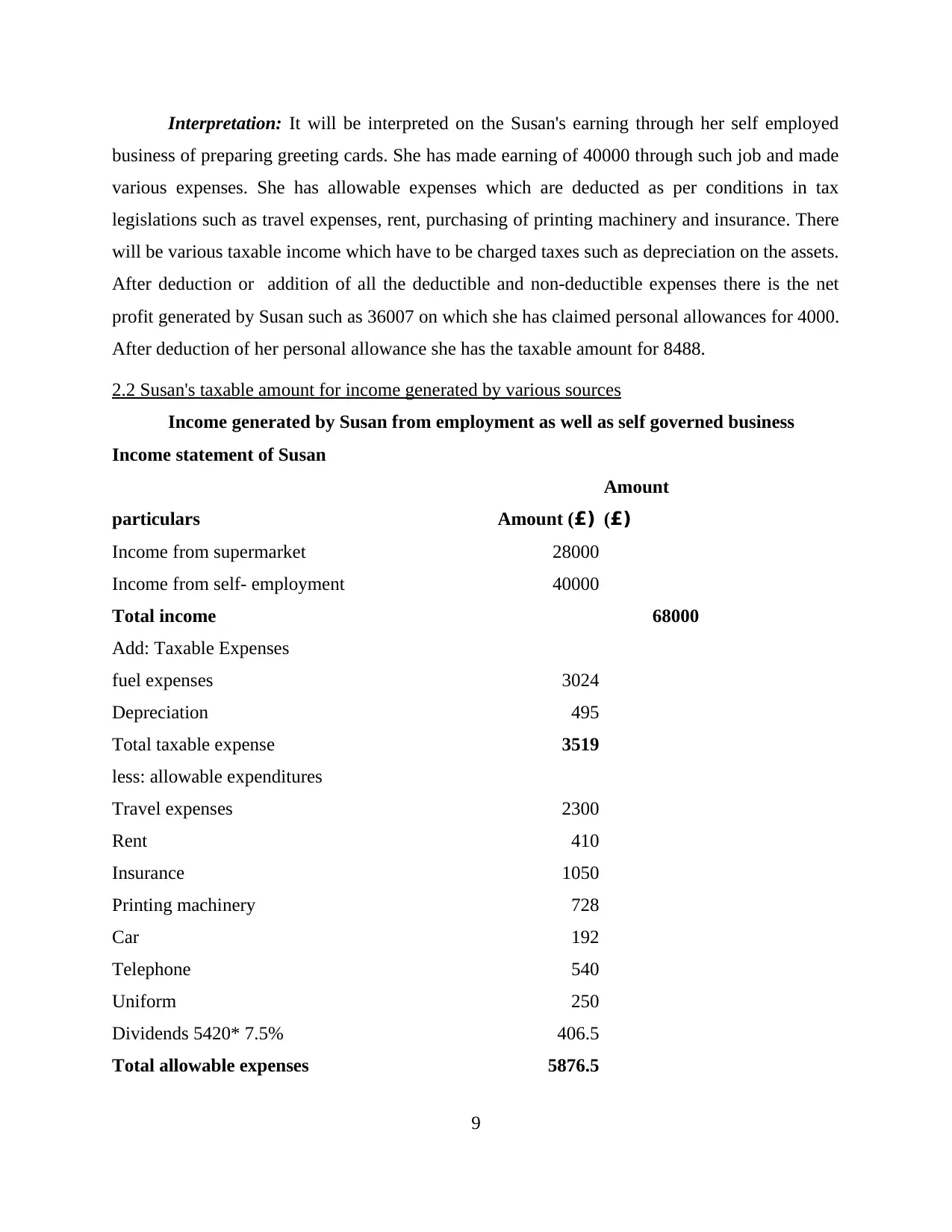
Interpretation: It will be interpreted on the Susan's earning through her self employed
business of preparing greeting cards. She has made earning of 40000 through such job and made
various expenses. She has allowable expenses which are deducted as per conditions in tax
legislations such as travel expenses, rent, purchasing of printing machinery and insurance. There
will be various taxable income which have to be charged taxes such as depreciation on the assets.
After deduction or addition of all the deductible and non-deductible expenses there is the net
profit generated by Susan such as 36007 on which she has claimed personal allowances for 4000.
After deduction of her personal allowance she has the taxable amount for 8488.
2.2 Susan's taxable amount for income generated by various sources
Income generated by Susan from employment as well as self governed business
Income statement of Susan
particulars Amount (£)
Amount
(£)
Income from supermarket 28000
Income from self- employment 40000
Total income 68000
Add: Taxable Expenses
fuel expenses 3024
Depreciation 495
Total taxable expense 3519
less: allowable expenditures
Travel expenses 2300
Rent 410
Insurance 1050
Printing machinery 728
Car 192
Telephone 540
Uniform 250
Dividends 5420* 7.5% 406.5
Total allowable expenses 5876.5
9
business of preparing greeting cards. She has made earning of 40000 through such job and made
various expenses. She has allowable expenses which are deducted as per conditions in tax
legislations such as travel expenses, rent, purchasing of printing machinery and insurance. There
will be various taxable income which have to be charged taxes such as depreciation on the assets.
After deduction or addition of all the deductible and non-deductible expenses there is the net
profit generated by Susan such as 36007 on which she has claimed personal allowances for 4000.
After deduction of her personal allowance she has the taxable amount for 8488.
2.2 Susan's taxable amount for income generated by various sources
Income generated by Susan from employment as well as self governed business
Income statement of Susan
particulars Amount (£)
Amount
(£)
Income from supermarket 28000
Income from self- employment 40000
Total income 68000
Add: Taxable Expenses
fuel expenses 3024
Depreciation 495
Total taxable expense 3519
less: allowable expenditures
Travel expenses 2300
Rent 410
Insurance 1050
Printing machinery 728
Car 192
Telephone 540
Uniform 250
Dividends 5420* 7.5% 406.5
Total allowable expenses 5876.5
9
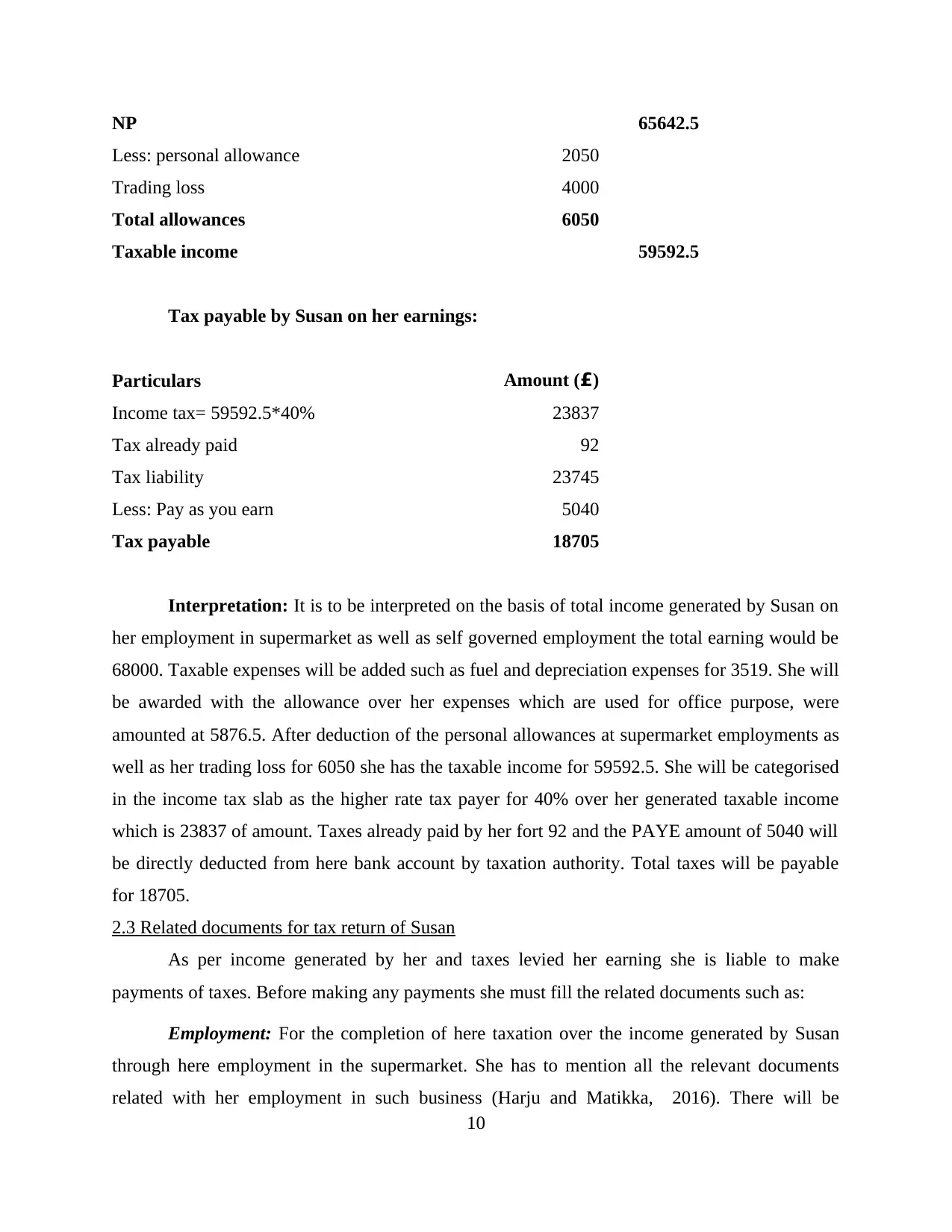
NP 65642.5
Less: personal allowance 2050
Trading loss 4000
Total allowances 6050
Taxable income 59592.5
Tax payable by Susan on her earnings:
Particulars Amount (£)
Income tax= 59592.5*40% 23837
Tax already paid 92
Tax liability 23745
Less: Pay as you earn 5040
Tax payable 18705
Interpretation: It is to be interpreted on the basis of total income generated by Susan on
her employment in supermarket as well as self governed employment the total earning would be
68000. Taxable expenses will be added such as fuel and depreciation expenses for 3519. She will
be awarded with the allowance over her expenses which are used for office purpose, were
amounted at 5876.5. After deduction of the personal allowances at supermarket employments as
well as her trading loss for 6050 she has the taxable income for 59592.5. She will be categorised
in the income tax slab as the higher rate tax payer for 40% over her generated taxable income
which is 23837 of amount. Taxes already paid by her fort 92 and the PAYE amount of 5040 will
be directly deducted from here bank account by taxation authority. Total taxes will be payable
for 18705.
2.3 Related documents for tax return of Susan
As per income generated by her and taxes levied her earning she is liable to make
payments of taxes. Before making any payments she must fill the related documents such as:
Employment: For the completion of here taxation over the income generated by Susan
through here employment in the supermarket. She has to mention all the relevant documents
related with her employment in such business (Harju and Matikka, 2016). There will be
10
Less: personal allowance 2050
Trading loss 4000
Total allowances 6050
Taxable income 59592.5
Tax payable by Susan on her earnings:
Particulars Amount (£)
Income tax= 59592.5*40% 23837
Tax already paid 92
Tax liability 23745
Less: Pay as you earn 5040
Tax payable 18705
Interpretation: It is to be interpreted on the basis of total income generated by Susan on
her employment in supermarket as well as self governed employment the total earning would be
68000. Taxable expenses will be added such as fuel and depreciation expenses for 3519. She will
be awarded with the allowance over her expenses which are used for office purpose, were
amounted at 5876.5. After deduction of the personal allowances at supermarket employments as
well as her trading loss for 6050 she has the taxable income for 59592.5. She will be categorised
in the income tax slab as the higher rate tax payer for 40% over her generated taxable income
which is 23837 of amount. Taxes already paid by her fort 92 and the PAYE amount of 5040 will
be directly deducted from here bank account by taxation authority. Total taxes will be payable
for 18705.
2.3 Related documents for tax return of Susan
As per income generated by her and taxes levied her earning she is liable to make
payments of taxes. Before making any payments she must fill the related documents such as:
Employment: For the completion of here taxation over the income generated by Susan
through here employment in the supermarket. She has to mention all the relevant documents
related with her employment in such business (Harju and Matikka, 2016). There will be
10

requirement of all the details regarding her salary break-up, shift timing and the hours of work
she does.
Self employment earning: Susan must file the documents related with her earning
through self governed business she must present all the necessary documents related with the
purchase and sales of the greeting cards in her business (Hasseldine ed., 2016). She must include
the details related with the expense done by her for the business purposes like purchasing the
material, equipments as well as machineries used for the manufacturing of greeting cards. Susan
will be benefited with the allowances and deductions awarded by UK taxation authority on her
trading loss as she includes all the specific details related with such transactions.
P87: Susan must fill the form as it facilitates the tax payer to claim the deductions over
uniform and travelling expenses done by them for office purpose (Ehrlich and Radulescu, 2017).
These expenses are not done by them for personalise use so it would not be added to her personal
income tax return. For claiming the deduction of such expenses she must mention all the
necessary informations related with that.
P60: Susan should fill the form of P60 as it is related with the information of employment
of a person in any firm, company as well as industries. She must mention all the necessary
details related with here employment in the supermarket (Ehrlich and Radulescu, 2017). There
must be document attached with the form, like employment contract, salary breakup, insurance
cover if provided by organisation. Susan must file such documents and submitted them to the
HMRC as for the best of their knowledge.
SA103F: The form is related to the self employment of a person and the generation of
income through such employment. Here, Susan must mention the purpose of her self
employment and the scope of her business (Ehrlich and Radulescu, 2017). She must include the
details related with sales and purchase of material in her business as well as profit earned by her.
M 3 Logical development of principle and concepts in analysing tax liabilities
By considering various principles and concepts which helps the UK government in
facilitating fair taxation. Hence, in accordance with the case of Susan she has to frill various
forms in context with filling the tax returns.
11
she does.
Self employment earning: Susan must file the documents related with her earning
through self governed business she must present all the necessary documents related with the
purchase and sales of the greeting cards in her business (Hasseldine ed., 2016). She must include
the details related with the expense done by her for the business purposes like purchasing the
material, equipments as well as machineries used for the manufacturing of greeting cards. Susan
will be benefited with the allowances and deductions awarded by UK taxation authority on her
trading loss as she includes all the specific details related with such transactions.
P87: Susan must fill the form as it facilitates the tax payer to claim the deductions over
uniform and travelling expenses done by them for office purpose (Ehrlich and Radulescu, 2017).
These expenses are not done by them for personalise use so it would not be added to her personal
income tax return. For claiming the deduction of such expenses she must mention all the
necessary informations related with that.
P60: Susan should fill the form of P60 as it is related with the information of employment
of a person in any firm, company as well as industries. She must mention all the necessary
details related with here employment in the supermarket (Ehrlich and Radulescu, 2017). There
must be document attached with the form, like employment contract, salary breakup, insurance
cover if provided by organisation. Susan must file such documents and submitted them to the
HMRC as for the best of their knowledge.
SA103F: The form is related to the self employment of a person and the generation of
income through such employment. Here, Susan must mention the purpose of her self
employment and the scope of her business (Ehrlich and Radulescu, 2017). She must include the
details related with sales and purchase of material in her business as well as profit earned by her.
M 3 Logical development of principle and concepts in analysing tax liabilities
By considering various principles and concepts which helps the UK government in
facilitating fair taxation. Hence, in accordance with the case of Susan she has to frill various
forms in context with filling the tax returns.
11
Paraphrase This Document
Need a fresh take? Get an instant paraphrase of this document with our AI Paraphraser
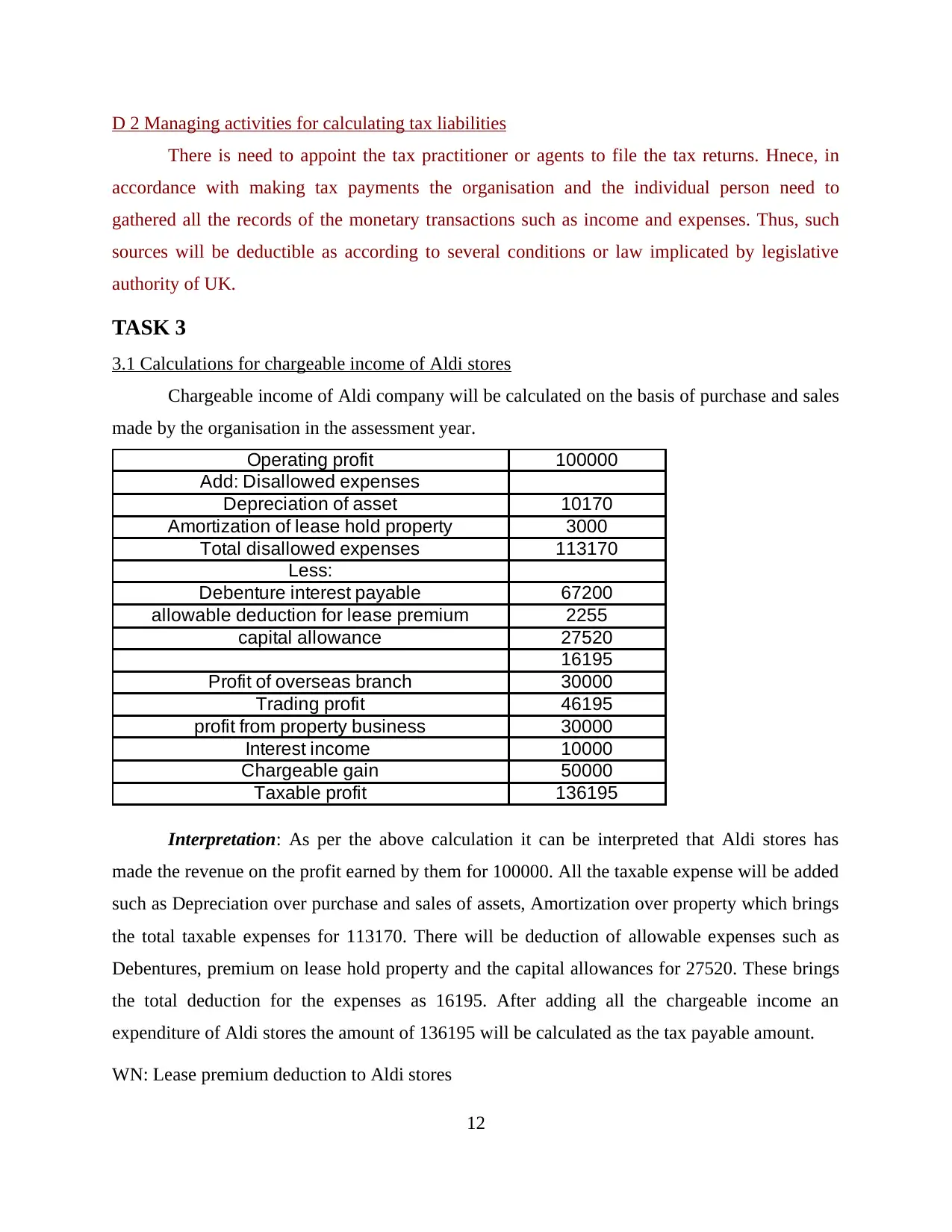
D 2 Managing activities for calculating tax liabilities
There is need to appoint the tax practitioner or agents to file the tax returns. Hnece, in
accordance with making tax payments the organisation and the individual person need to
gathered all the records of the monetary transactions such as income and expenses. Thus, such
sources will be deductible as according to several conditions or law implicated by legislative
authority of UK.
TASK 3
3.1 Calculations for chargeable income of Aldi stores
Chargeable income of Aldi company will be calculated on the basis of purchase and sales
made by the organisation in the assessment year.
Operating profit 100000
Add: Disallowed expenses
Depreciation of asset 10170
Amortization of lease hold property 3000
Total disallowed expenses 113170
Less:
Debenture interest payable 67200
allowable deduction for lease premium 2255
capital allowance 27520
16195
Profit of overseas branch 30000
Trading profit 46195
profit from property business 30000
Interest income 10000
Chargeable gain 50000
Taxable profit 136195
Interpretation: As per the above calculation it can be interpreted that Aldi stores has
made the revenue on the profit earned by them for 100000. All the taxable expense will be added
such as Depreciation over purchase and sales of assets, Amortization over property which brings
the total taxable expenses for 113170. There will be deduction of allowable expenses such as
Debentures, premium on lease hold property and the capital allowances for 27520. These brings
the total deduction for the expenses as 16195. After adding all the chargeable income an
expenditure of Aldi stores the amount of 136195 will be calculated as the tax payable amount.
WN: Lease premium deduction to Aldi stores
12
There is need to appoint the tax practitioner or agents to file the tax returns. Hnece, in
accordance with making tax payments the organisation and the individual person need to
gathered all the records of the monetary transactions such as income and expenses. Thus, such
sources will be deductible as according to several conditions or law implicated by legislative
authority of UK.
TASK 3
3.1 Calculations for chargeable income of Aldi stores
Chargeable income of Aldi company will be calculated on the basis of purchase and sales
made by the organisation in the assessment year.
Operating profit 100000
Add: Disallowed expenses
Depreciation of asset 10170
Amortization of lease hold property 3000
Total disallowed expenses 113170
Less:
Debenture interest payable 67200
allowable deduction for lease premium 2255
capital allowance 27520
16195
Profit of overseas branch 30000
Trading profit 46195
profit from property business 30000
Interest income 10000
Chargeable gain 50000
Taxable profit 136195
Interpretation: As per the above calculation it can be interpreted that Aldi stores has
made the revenue on the profit earned by them for 100000. All the taxable expense will be added
such as Depreciation over purchase and sales of assets, Amortization over property which brings
the total taxable expenses for 113170. There will be deduction of allowable expenses such as
Debentures, premium on lease hold property and the capital allowances for 27520. These brings
the total deduction for the expenses as 16195. After adding all the chargeable income an
expenditure of Aldi stores the amount of 136195 will be calculated as the tax payable amount.
WN: Lease premium deduction to Aldi stores
12
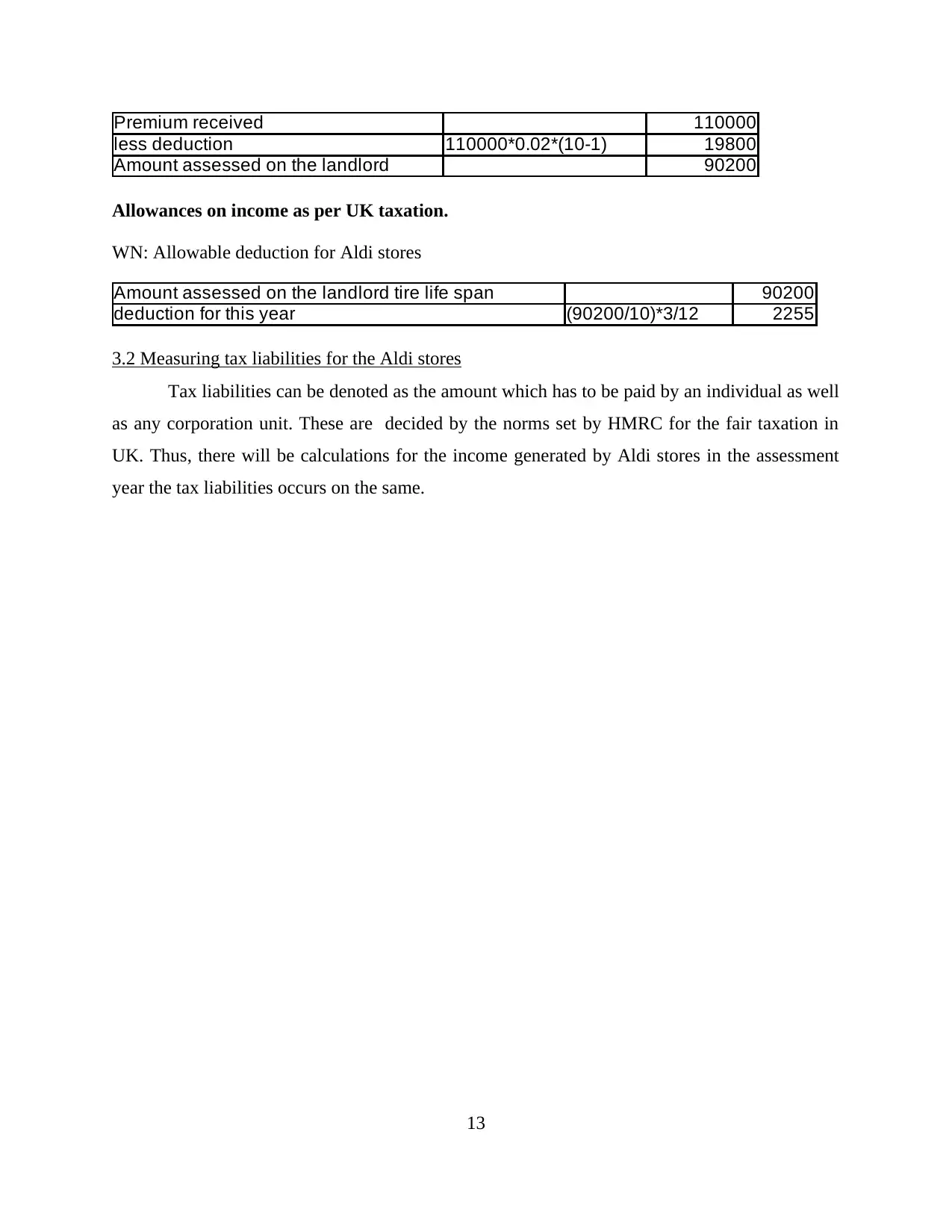
Premium received 110000
less deduction 110000*0.02*(10-1) 19800
Amount assessed on the landlord 90200
Allowances on income as per UK taxation.
WN: Allowable deduction for Aldi stores
Amount assessed on the landlord tire life span 90200
deduction for this year (90200/10)*3/12 2255
3.2 Measuring tax liabilities for the Aldi stores
Tax liabilities can be denoted as the amount which has to be paid by an individual as well
as any corporation unit. These are decided by the norms set by HMRC for the fair taxation in
UK. Thus, there will be calculations for the income generated by Aldi stores in the assessment
year the tax liabilities occurs on the same.
13
less deduction 110000*0.02*(10-1) 19800
Amount assessed on the landlord 90200
Allowances on income as per UK taxation.
WN: Allowable deduction for Aldi stores
Amount assessed on the landlord tire life span 90200
deduction for this year (90200/10)*3/12 2255
3.2 Measuring tax liabilities for the Aldi stores
Tax liabilities can be denoted as the amount which has to be paid by an individual as well
as any corporation unit. These are decided by the norms set by HMRC for the fair taxation in
UK. Thus, there will be calculations for the income generated by Aldi stores in the assessment
year the tax liabilities occurs on the same.
13
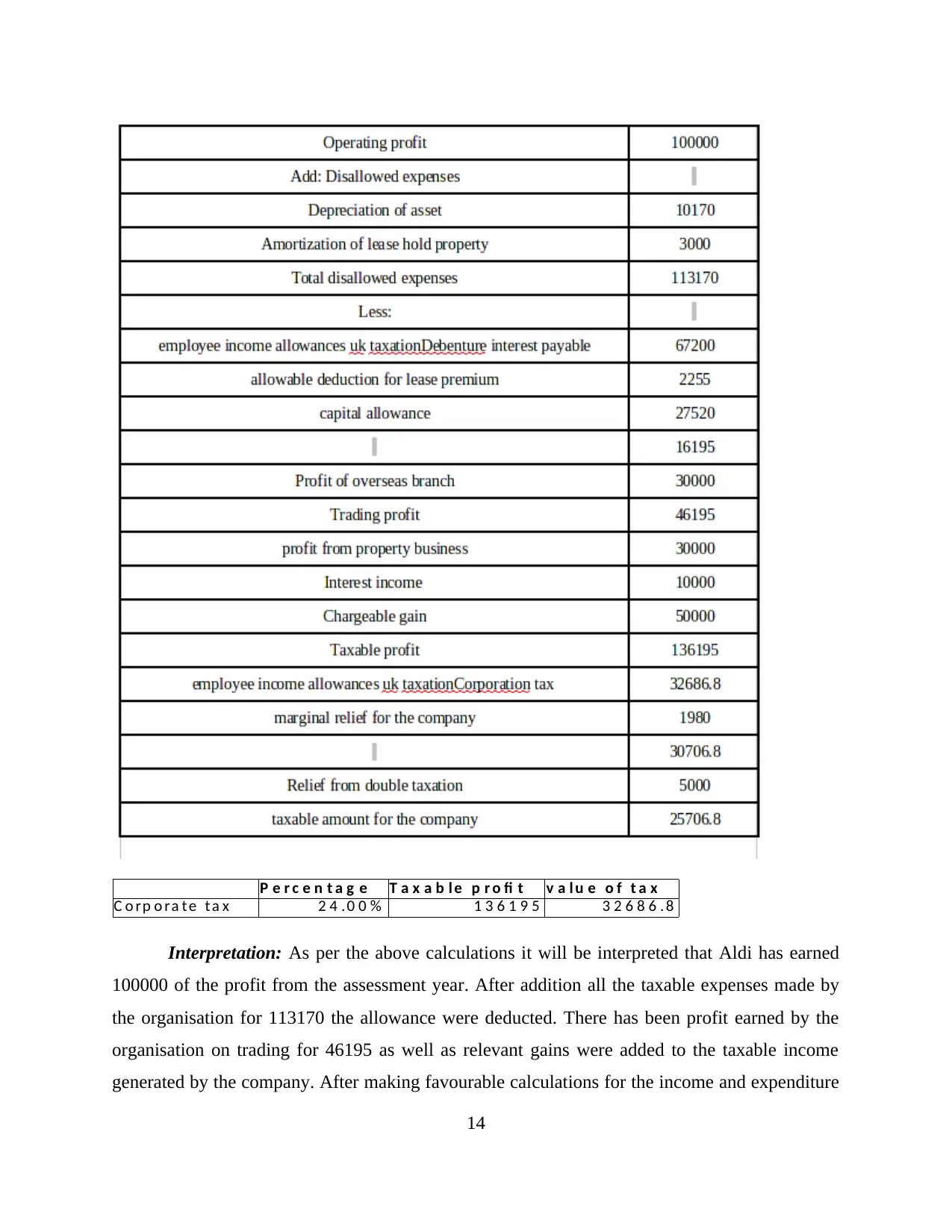
P e r c e n t a g e T a x a b l e p r o fi t v a l u e o f t a x
C o rp o ra t e t a x 2 4 . 0 0 % 1 3 6 1 9 5 3 2 6 8 6 . 8
Interpretation: As per the above calculations it will be interpreted that Aldi has earned
100000 of the profit from the assessment year. After addition all the taxable expenses made by
the organisation for 113170 the allowance were deducted. There has been profit earned by the
organisation on trading for 46195 as well as relevant gains were added to the taxable income
generated by the company. After making favourable calculations for the income and expenditure
14
C o rp o ra t e t a x 2 4 . 0 0 % 1 3 6 1 9 5 3 2 6 8 6 . 8
Interpretation: As per the above calculations it will be interpreted that Aldi has earned
100000 of the profit from the assessment year. After addition all the taxable expenses made by
the organisation for 113170 the allowance were deducted. There has been profit earned by the
organisation on trading for 46195 as well as relevant gains were added to the taxable income
generated by the company. After making favourable calculations for the income and expenditure
14
Secure Best Marks with AI Grader
Need help grading? Try our AI Grader for instant feedback on your assignments.
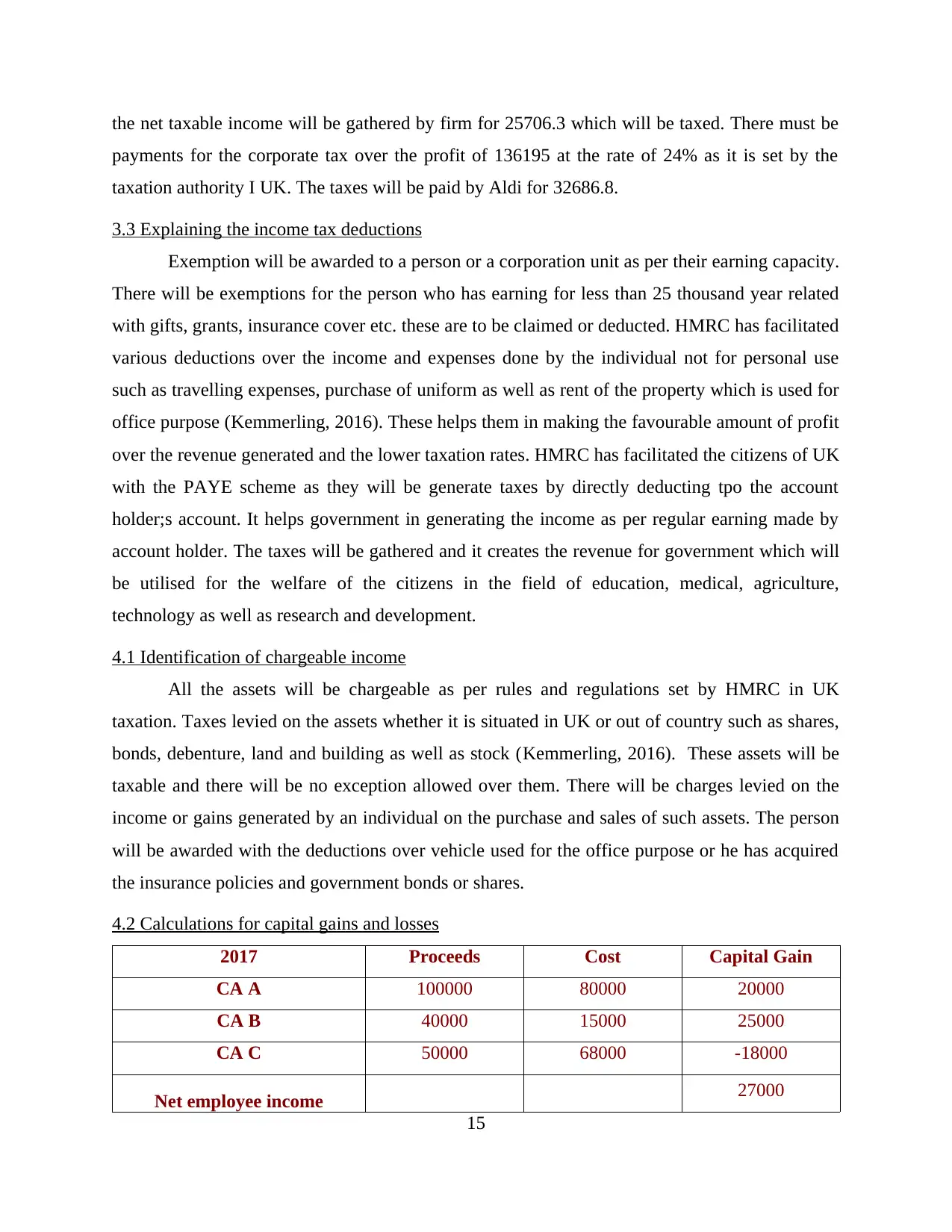
the net taxable income will be gathered by firm for 25706.3 which will be taxed. There must be
payments for the corporate tax over the profit of 136195 at the rate of 24% as it is set by the
taxation authority I UK. The taxes will be paid by Aldi for 32686.8.
3.3 Explaining the income tax deductions
Exemption will be awarded to a person or a corporation unit as per their earning capacity.
There will be exemptions for the person who has earning for less than 25 thousand year related
with gifts, grants, insurance cover etc. these are to be claimed or deducted. HMRC has facilitated
various deductions over the income and expenses done by the individual not for personal use
such as travelling expenses, purchase of uniform as well as rent of the property which is used for
office purpose (Kemmerling, 2016). These helps them in making the favourable amount of profit
over the revenue generated and the lower taxation rates. HMRC has facilitated the citizens of UK
with the PAYE scheme as they will be generate taxes by directly deducting tpo the account
holder;s account. It helps government in generating the income as per regular earning made by
account holder. The taxes will be gathered and it creates the revenue for government which will
be utilised for the welfare of the citizens in the field of education, medical, agriculture,
technology as well as research and development.
4.1 Identification of chargeable income
All the assets will be chargeable as per rules and regulations set by HMRC in UK
taxation. Taxes levied on the assets whether it is situated in UK or out of country such as shares,
bonds, debenture, land and building as well as stock (Kemmerling, 2016). These assets will be
taxable and there will be no exception allowed over them. There will be charges levied on the
income or gains generated by an individual on the purchase and sales of such assets. The person
will be awarded with the deductions over vehicle used for the office purpose or he has acquired
the insurance policies and government bonds or shares.
4.2 Calculations for capital gains and losses
2017 Proceeds Cost Capital Gain
CA A 100000 80000 20000
CA B 40000 15000 25000
CA C 50000 68000 -18000
Net employee income 27000
15
payments for the corporate tax over the profit of 136195 at the rate of 24% as it is set by the
taxation authority I UK. The taxes will be paid by Aldi for 32686.8.
3.3 Explaining the income tax deductions
Exemption will be awarded to a person or a corporation unit as per their earning capacity.
There will be exemptions for the person who has earning for less than 25 thousand year related
with gifts, grants, insurance cover etc. these are to be claimed or deducted. HMRC has facilitated
various deductions over the income and expenses done by the individual not for personal use
such as travelling expenses, purchase of uniform as well as rent of the property which is used for
office purpose (Kemmerling, 2016). These helps them in making the favourable amount of profit
over the revenue generated and the lower taxation rates. HMRC has facilitated the citizens of UK
with the PAYE scheme as they will be generate taxes by directly deducting tpo the account
holder;s account. It helps government in generating the income as per regular earning made by
account holder. The taxes will be gathered and it creates the revenue for government which will
be utilised for the welfare of the citizens in the field of education, medical, agriculture,
technology as well as research and development.
4.1 Identification of chargeable income
All the assets will be chargeable as per rules and regulations set by HMRC in UK
taxation. Taxes levied on the assets whether it is situated in UK or out of country such as shares,
bonds, debenture, land and building as well as stock (Kemmerling, 2016). These assets will be
taxable and there will be no exception allowed over them. There will be charges levied on the
income or gains generated by an individual on the purchase and sales of such assets. The person
will be awarded with the deductions over vehicle used for the office purpose or he has acquired
the insurance policies and government bonds or shares.
4.2 Calculations for capital gains and losses
2017 Proceeds Cost Capital Gain
CA A 100000 80000 20000
CA B 40000 15000 25000
CA C 50000 68000 -18000
Net employee income 27000
15
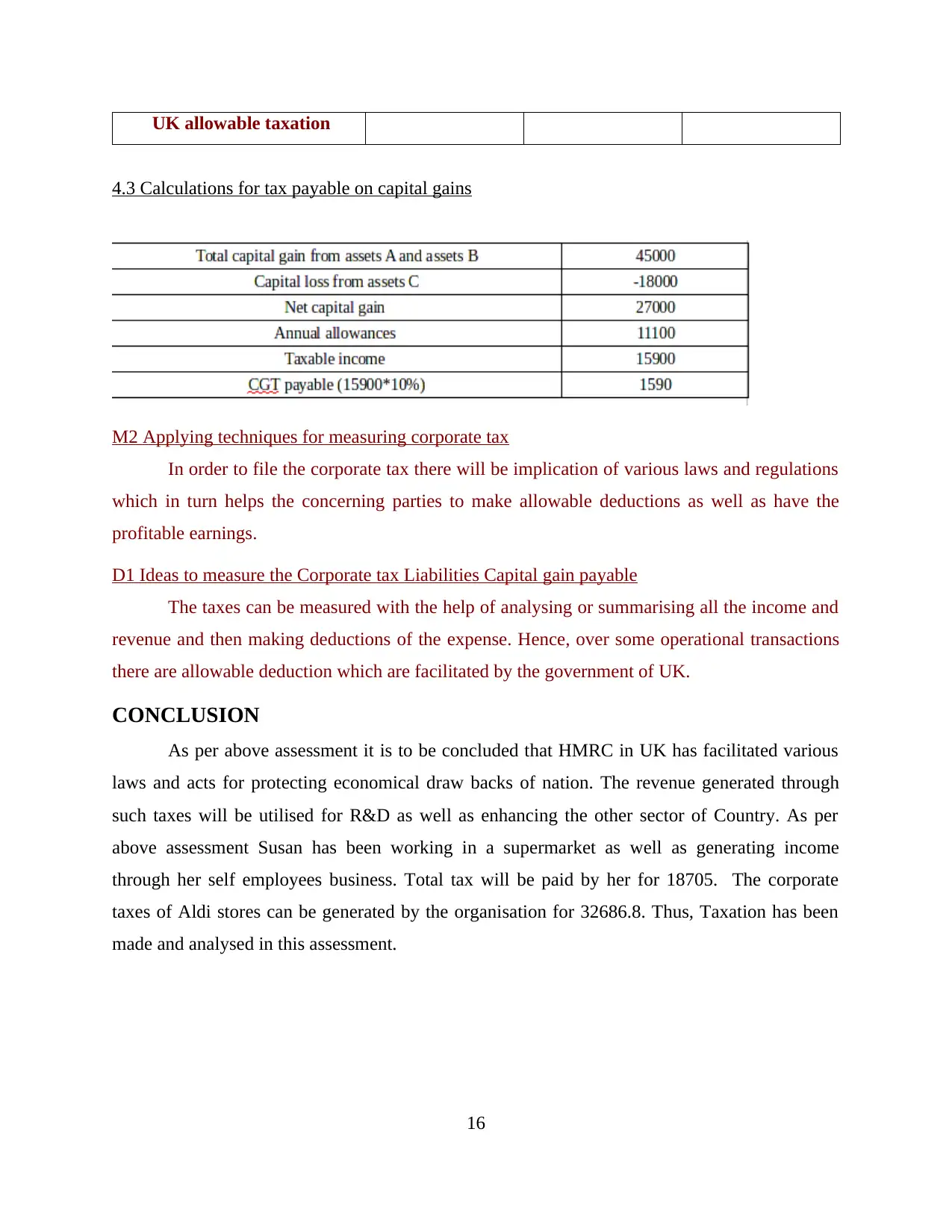
UK allowable taxation
4.3 Calculations for tax payable on capital gains
M2 Applying techniques for measuring corporate tax
In order to file the corporate tax there will be implication of various laws and regulations
which in turn helps the concerning parties to make allowable deductions as well as have the
profitable earnings.
D1 Ideas to measure the Corporate tax Liabilities Capital gain payable
The taxes can be measured with the help of analysing or summarising all the income and
revenue and then making deductions of the expense. Hence, over some operational transactions
there are allowable deduction which are facilitated by the government of UK.
CONCLUSION
As per above assessment it is to be concluded that HMRC in UK has facilitated various
laws and acts for protecting economical draw backs of nation. The revenue generated through
such taxes will be utilised for R&D as well as enhancing the other sector of Country. As per
above assessment Susan has been working in a supermarket as well as generating income
through her self employees business. Total tax will be paid by her for 18705. The corporate
taxes of Aldi stores can be generated by the organisation for 32686.8. Thus, Taxation has been
made and analysed in this assessment.
16
4.3 Calculations for tax payable on capital gains
M2 Applying techniques for measuring corporate tax
In order to file the corporate tax there will be implication of various laws and regulations
which in turn helps the concerning parties to make allowable deductions as well as have the
profitable earnings.
D1 Ideas to measure the Corporate tax Liabilities Capital gain payable
The taxes can be measured with the help of analysing or summarising all the income and
revenue and then making deductions of the expense. Hence, over some operational transactions
there are allowable deduction which are facilitated by the government of UK.
CONCLUSION
As per above assessment it is to be concluded that HMRC in UK has facilitated various
laws and acts for protecting economical draw backs of nation. The revenue generated through
such taxes will be utilised for R&D as well as enhancing the other sector of Country. As per
above assessment Susan has been working in a supermarket as well as generating income
through her self employees business. Total tax will be paid by her for 18705. The corporate
taxes of Aldi stores can be generated by the organisation for 32686.8. Thus, Taxation has been
made and analysed in this assessment.
16
1 out of 18
Related Documents
Your All-in-One AI-Powered Toolkit for Academic Success.
+13062052269
info@desklib.com
Available 24*7 on WhatsApp / Email
![[object Object]](/_next/static/media/star-bottom.7253800d.svg)
Unlock your academic potential
© 2024 | Zucol Services PVT LTD | All rights reserved.





